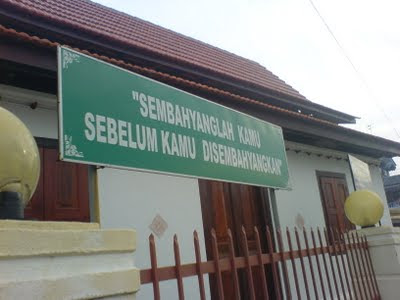MOSQUE RENOVATIONS 2007
Masjid Bandar Hilir was built
circa 1820, so said the govt page at
http://www.islamgrid.gov.my/mosque/detailed.php?id=3001.
Maklumat Lanjut
No Daftar: MY-04-MT-00118
Nama Masjid: MASJID BANDAR HILIR
Alamat: KM 1.5, BANDA HILIR,
75000 MELAKA
Masjid Banda Hilir ini dibina kali pertamanya dalam tahun 1820 dan pada
tahun 1960 masjid ini dibaharui dengan belanja orang ramai.
Where did they get the information? Who then rebuild the mosque after WWII? Bapak did. With whose $? I don't know.
Who lived next to Masjid Bandar Hilir? Our ancestors, 8 generations of them. They were Arabs from Hadramaut in Yemen (orang dari Yaman).
Where are the graves of these early Yemeni people who came to Malacca? In the graveyard of Masjid Semabok as Masjid Bandar Hilir only had a small plot of land for the graves and that was relocated elsewhere when I lived there till I was 5 (1958-1963). My ancestors lived beside Masjid Bandar Hilir but were buried in the graveyard of Masjid Semabok.
1820 was the Dutch era in Malacca, just prior to its handing over to the British.
-----
Photos of Masjid Banda Hilir
Masjid An-Nur Banda Hilir
All photos are from Bapak's pendrive which I obtained in 2011. He died in 2009.
 |
| Projek: Kerja-Kerja Membaikpulih Masjid An-Nur Banda Hilir, Melaka. Kontraktor: AZH Puncak Bakti Enterprise. Pegawai Penguasa: PERZIM. Tarikh Mula: 22 Januari 2007. Tarikh Siap: 2 April 2007 |
 |
| Projek Penyelenggaraan Infrastruktur Asas/Awam Luar Bandar Tahun 2007. Nama Kontraktor: Syahrizan Jaya Enterprise (Lesen Pendaftaran: MA 0062048-T). Nama Projek: Membaikpulih Masjid Lama Banda Hilir (DUN Bandar Hilir). Tarikh Mula Projek: 17 Mei 2007. Tarikh Siap Projek: 17 Jun 2007. |
 |
| After renovation. The building at right is the old one. |
 |
| Masjid Banda Hilir is now renamed to Masjid An Nur but we still call it Masjid Banda Hilir |
------------------
TANAH WAKAF MASJID BANDA HILIR
Lot 96
Kg Banda Hilir
Saiz Lot 96 ialah kawasan tanah wakaf Masjid Banda Hilir.
Kawasan Masjid Banda Hilir (Lot 96) berukuran 43771 kaki per segi (43771 sq ft). Bahagian hadapan didirikan Masjid Banda Hilir pada 1820.
Selepas Masjid ialah rumah Hj Mohd Sharif bin Ismail beralamat 262-T Banda Hilir,
Kemudian rumah Nenek Ani bersambung dan berkongsi dinding dengan rumah bapanya.
Kemudian bangsal Nenek Jah.
Kemudian rumah Mak Sarah.
Kemudian rumah Nenek Ya (Ya Tampin).
Jamban dibuang keseluruhanny apabila jamban baru dalam rumah telah dibina pada 1972-73.
Belakang rumah Mak Sarah ialah rumah Pak Habib.
Kemudian rumah zink pekerja Cina (Chinese labourers).
Mereka menetap dan menyewa rumah2 zink berpintu kayu yang dibina, serta kepunyaan Hj Mohd Sharif. Setelah beliau meninggal dunia, dan selepas 1960-an, mereka enggan membayar sewa rumah dan enggan keluar daripada rumah sewa mereka. Mereka mendakwa rumah zink berkenaan mereka punya. Rumah zink telah berubah rupa menjadi rumah batu kekal. Namun mereka tetap penduduk haram dan menduduki tanah wakaf secara haram. Tanah yang mereka duduki telah lama diwakafkan oleh keturunan Hj Mohd Sharif bagi Masjid Banda Hilir. Jadi Jawatankuasa Masjid perlu mengguna jalan sedia ada (menerusi perintah mahkamah) untuk mendapatkan semula tanah wakaf Hj Mohd Sharif yang diduduki oleh orang2 Cina iaitu tanah wakaf Masjid Banda Hilir. Kegagalan mendapatkan semula tanah wakaf ini merugikan pihak Masjid Banda Hilir kerana tidak dapat dibangunkan untuk kegunaan Masjid.
Bahagian pink = peta Lot 96 overlap dengan Google Map data (tidak mengikut skala)
A = Bahagian Masjid dan rumah2 sedia ada dalam kawasan pagar Masjid
B = Kawasan Tanah Wakaf Masjid yang diduduki secara haram oleh orang2 Cina sejak dahulu (1960-an).
 |
| Peta tidak mengikut skala |












